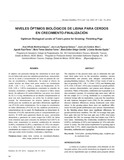Mostrar el registro sencillo del ítem
Niveles óptimos biológicos de lisina para cerdos en crecimiento finalización
| dc.rights.license | http://creativecommons.org/licenses/by-nc-sa/3.0/ve/ | |
| dc.contributor.author | Martínez, José A. | |
| dc.contributor.author | Figueroa, José Luis | |
| dc.contributor.author | Cordero Mora, José Luis | |
| dc.contributor.author | Ruíz Flores, Agustín | |
| dc.contributor.author | Sánchez Torres, María Teresa | |
| dc.contributor.author | Ortega Cerrilla, María Esther | |
| dc.contributor.author | Narciso Gaytán, Carlos | |
| dc.date.accessioned | 2014-04-10T10:10:57Z | |
| dc.date.available | 2014-04-10T10:10:57Z | |
| dc.date.issued | 2014-04-10T10:10:57Z | |
| dc.identifier.issn | 0798-2259 | |
| dc.identifier.uri | http://www.saber.ula.ve/handle/123456789/38372 | |
| dc.description.abstract | El objetivo del presente trabajo fue determinar el nivel óptimo de lisina total para las variables productivas, características de la canal y concentración de urea en plasma de cerdos en crecimiento y finalización. Se evaluó el efecto de cuatro niveles de lisina total para cerdos en crecimiento (0,95; 1,05; 1,15 y 1,25%) y cuatro en finalización (0,75; 0,85; 0,95 y 1,05%) manteniendo constante la relación de treonina, metionina y triptófano con respecto a lisina (base ideal). Se utilizaron 24 cerdos híbridos, con peso vivo inicial de 23,3 ± 3,4 kg, distribuidos en un diseño completamente al azar con seis repeticiones, un cerdo fue la unidad experimental. Se determinaron los niveles óptimos biológicos (NOB) para las variables en que hubo diferencias significativas (P<0,05) entre tratamientos. En la etapa de crecimiento no hubo diferencias (P>0,05) en las variables productivas y características de la canal. En finalización se detectaron diferencias (P<0,05) únicamente para el comportamiento productivo. El NOB para ganancia diaria de peso, conversión alimenticia y ganancia de carne magra fue 0,88% de lisina total; mientras que para consumo de alimento fue 0,961% de lisina total; respetando la relación establecida de treonina (0,68%), metionina (0,26%) y triptófano (0,18%) con respecto a lisina. El requerimiento de lisina total para cerdos en crecimiento es mayor a 0,75%, debiéndose respetar la relación que existe entre treonina, metionina y triptófano. | es_VE |
| dc.language.iso | es | es_VE |
| dc.rights | info:eu-repo/semantics/openAccess | |
| dc.subject | Lisina total | es_VE |
| dc.subject | Cerdos en crecimiento-finalización | es_VE |
| dc.subject | Sorgo | es_VE |
| dc.subject | Pasta de soya | es_VE |
| dc.title | Niveles óptimos biológicos de lisina para cerdos en crecimiento finalización | es_VE |
| dc.title.alternative | Optimum biological levels of total lysine for growing- finishing pigs | es_VE |
| dc.type | info:eu-repo/semantics/article | |
| dc.description.abstract1 | The objective of the present study was to determine the optimum total lysine level on the productive variables, carcass characteristics and plasma urea nitrogen concentration in growing-finishing barrows. The effect of four levels of total lysine on growing (0.95, 1.05, 1.15 and 1.25%) and finishing pigs (0.75, 0.85, 0.95 and 1.05%) was evaluated on growth performance, carcass characteristics, and plasma urea nitrogen concentration. Ratios of threonine, methionine and tryptophan to lysine remained constant. 24 crossbred pigs were used, with initial live weight 23.3 ± 3.4 kg, distributed in a completely randomized design with six replications, a pig was the experimental unit. Optimum biological levels (OBL) for the variables that showed statistical differences among treatments were determined. In the growing phase there were not significant differences for both growth performance and carcass characteristics. In the finishing phase there were significant differences for growth performance variables. The OBL for average daily gain, feed: gain ratio and fat free lean gain was 0.88% total lysine; meanwhile the OBL for average daily feed intake was 0.961% total lysine. Maintaining the relationship established threonine (0.68%), methionine (0.26%) and tryptophan (0.18%) with referenced to lysine. The total lysine requirement for growing pigs is greater than 0.75%, whilst respecting the relationship between threonine, methionine and tryptophan. | es_VE |
| dc.description.colacion | 64 - 72 | es_VE |
| dc.description.email | jlfigueroa@colpos.mx | es_VE |
| dc.identifier.depositolegal | 199102ZU46 | |
| dc.publisher.pais | Venezuela | es_VE |
| dc.subject.institucion | Universidad del Zulia (LUZ) | es_VE |
| dc.subject.institucion | Universidad de Los Andes (ULA) | es_VE |
| dc.subject.keywords | Total lysine | es_VE |
| dc.subject.keywords | Growing-finishing pigs | es_VE |
| dc.subject.keywords | Sorghum grain | es_VE |
| dc.subject.keywords | Soybean meal | es_VE |
| dc.subject.publicacionelectronica | Revista Científica | |
| dc.subject.seccion | Revista Científica: Producción Animal | es_VE |
| dc.subject.thematiccategory | Medio Ambiente | es_VE |
| dc.subject.tipo | Revistas | es_VE |
| dc.type.media | Texto | es_VE |
Ficheros en el ítem
Este ítem aparece en la(s) siguiente(s) colección(ones)
-
Revista Científica - 2014 - Vol. XXIV - No. 001
Enero - Febrero 2014


